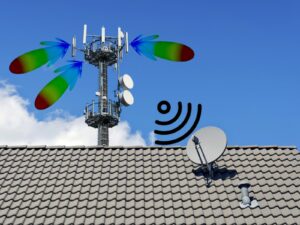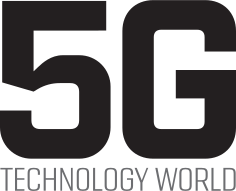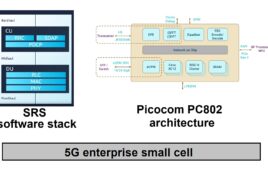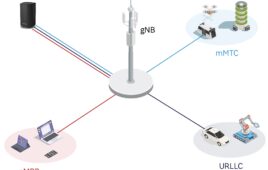At a press conference with 5G Technology World present, the 12 GHz for 5G Coalition continued its effort to change FCC rules and open 500 MHz for terrestrial use.
Washington — As the battle over use of the 12.2 GHz to 12.7 GHz rages, the 5G for 12 GHz Coalition held a press conference on October 13 to once again state it’s position that the FCC should change the rules and allow terrestrial 5G transmission in this frequency band. Current rules allow for downlink only use for satellite TV.

Satellite and terrestrial 5G signals travel at different angles relative to the Earth.
The push for 12 GHz began in October 2020 with a letter to then FCC Chairman Ajit Pai. Since that time, incumbents AT&T and SpaceX have opposed the shared spectrum use on grounds that terrestrial 5G would interfere with their services, disrupting transmissions to customers. Another incumbent, DISH, is part of coalition because it’s building a 5G network and already has licenses in the band for its satellite TV services.
The coalition hired RKF Engineering to analyze possible interference. The report, Assessment of Feasibility of Coexistence between NGSO FSS Earth Stations and 5G Operations in the 12.2 – 12.7 GHz Band, issued May 21, 2021 concludes that less than 0.15% of SpaceX’s Starlink users would be affected. That’s based on the transmission angle of satellite signal compared with Earth-bound 5G signals.
Keep in mind that a rule change is still needed for SpaceX to use the 12 GHz band for its 12,000 Starlink for internet access. Current rules allow for downlink transmission only, so Starlink uses frequencies outside 12.2 GHz to 12.7 GHz for its internet services. The coalition argues that Starlink has 1500 MHz of spectrum available for its use that’s outside of the 500 MHz in question and 5G services should have permission to use it.
The simulations cited in the RKF report make for a good start, but they’re still simulations. I asked what’s being done to simulate the actual conditions with real signals. Granted, you can’t simply build a 5G tower in a populated area and test for interference. You can, however, simulate conditions in a chamber or test in a location that lacks satellite subscribers using the band in question. In the video, Blum replied that tests using actual signals are coming.
The video, courtesy of 5G for 12 GHz Coalition, contains the complete press conference including audience questions. Speakers, in order of appearance:
- Angie Kronenberg, Incompas cited U.S. interests in using the 12 GHz band for terrestrial two-way services and the band can be used 99.85% of the time without interference to incumbents.
- V. Noah Campbell, RS Access cited the need for coexistence and spectrum sharing will be needed more as time goes on. “We’re confident in the studies that we’ve put forward. Let’s finish the work.”
- Jeff Blum, Dish noted that his company is an incumbent in the 12 GHz band. “If we thought that using 12 GHz for 5G would interfere with our customers, we wouldn’t use it.” Blum claims that opponents of using 12 GHz for terrestrial 5G are using worst-case analysis to make their point with exaggerated claims.
- Harold Feld, Public Knowledge argued that the 12 GHz band is about more than 5G. “It’s a fundamental test case for sharing spectrum. There are no federal users and we have known incumbents.” If successful, this and other forms of spectrum sharing can increase useable spectrum for new services.
- Andy Schwartzman, Benton Institute for Broadband and Society argued that “Consumers need competitive markets. Opening the 12 GHz band does that.” He also noted that Dish is building a 5G network using Open RAN, which is a test case for using the technology at scale.
5G Technology World takes no position on this issue and welcomes all opinions.





In a similar development, Wi-Fi Now reported “Wi-Fi Alliance calls on policy makers: 5G/IMT deployments in the 6 GHz band are not feasible.” The article refers to the upper half of the 5.925 – 7.125 GHz Wi-Fi 6E band. The article states:
As policy makers prepare for next year’s ITU World Radiocommunication Conference 2023 (WRC-23) the issue of how to allocate especially the top half of the 6 GHz band looms large. A new paper by Wi-Fi Alliance cuts to the chase by deeming 5G/IMT deployments in the 6 GHz band simply ‘not feasible’. They are right, of course.
The article was written by Claus Hetting, Wi-Fi NOW CEO & Chairman, who obviously has a stake in Wi-Fi.
What’s your take in the 6 GHz and 12 GHz controversies?